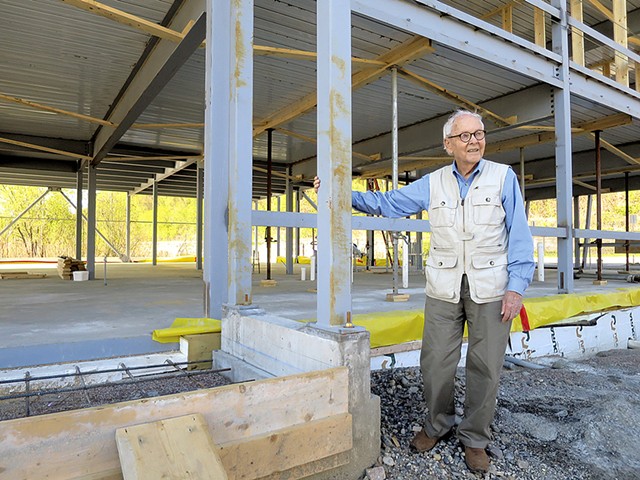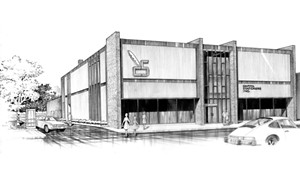
- Matthew Thorsen
- Marcel Beaudin
If the Queen City has a crown, it might be the public-minded waterfront. And one of its brightly shining gems is the Community Sailing Center. The facility's mission is to make sailing — an activity historically associated with wealthy white men — accessible to everyone.
Because of the CSC, every year some 6,000 people, including almost 1,900 children, sail or paddle in boats they don't have to own, maintain, store or insure. The Burlington center, dependent on philanthropy and revenue from classes, asks for none of the membership or annual fees associated with yacht clubs. A dinghy sailboat can be rented for $30 per hour, a paddleboard for half that.
Now the CSC is about to get a new home. Though it won't be fully operational until the fall, the Raymond P. Sullivan Sailing Education Center at the Pomerleau Community Waterfront Campus (named for two major donors) will have a soft opening in late July. The ground was broken last October, and the 22,000-square-foot, multistory waterfront building is currently taking shape beside the Andy A-Dog Williams Skatepark. When finished, it will feature net-zero energy use, classrooms, showers, indoor boat storage and a third-floor, covered event deck with southwest views of the water.
This generous design is the work of Marcel Beaudin, 88, a South Burlington architect who has been practicing in Vermont since 1957. While it took the vision and determination of many people to raise $5.75 million for this community center, Beaudin can be credited with a guiding role.
Beaudin is more than the building's architect; he's responsible for Burlington having a community sailing center at all. An enthusiastic sailor and member of the Lake Champlain Yacht Club in Shelburne for more than 40 years, he led a group of friends and fellow sailors in founding the CSC in 1994.
Over the years, the center has found makeshift quarters in the leaky, abandoned Moran Plant and, after 2007, in the old Burlington Water Works building — essentially a garage where the bathrooms are three portable toilets.
The new facility will be of a different order. Seated in a construction trailer beside its framed-out bones on a recent rainy morning, Beaudin dealt cheerfully with both a reporter and the workers. The latter popped in to consult with the architect on floor-pouring plans, tiling and color swatches.
Beaudin's upbeat mood was understandable. The new facility, he said with a broad smile, is "a dream come true."
Beaudin would seem an unlikely champion for the concept of a community sailing center. He continues to pay almost $1,000 a year in yacht-club fees and has owned many boats over his lifetime. (He sold his last, a 23-foot Sonar, a year ago with the provision that he be able to borrow it to race in the LCYC's Ladies Cup Race in August.) But Beaudin was always bothered by the perception of sailing as an elite sport. "I smarted under that association," he said. The vision of a facility where anyone can learn to sail has been with him for decades, he said, and may well date back to his training as an architect.
Beaudin's professional development has been well documented, thanks in part to a retrospective of his architectural work mounted by Burlington City Arts in 2005 and a 2012 interview with Dwell magazine. But his story bears repeating.
The Barre native was born in 1929 into a stone-carving family with centuries-old roots in the business. Yet in 1947 he decided, on the spur of the moment, to become an architect. The catalyst was a chance visit to Le Corbusier's studio in New York, where the Swiss-French architect had come to build the United Nations complex.
Beaudin enrolled immediately at Pratt Institute, where he absorbed the form-follows-function mantra of the era's famous modernist architects. In an interview at his small but meticulously arranged office on Shelburne Road, Beaudin explained that he honed his design-competition skills at Pratt, in part by serving juries coffee to learn how they worked.
"I won a lot of competitions," he said with a smile. For one of them, sponsored by Indiana Limestone, he designed a structure with an interior frieze depicting the history of jurisprudence. The addition of ornamentation, which served a psychological purpose in Beaudin's opinion but ran against the "functional" mantra, disturbed his modernist professors but won him the contest.
By the time Beaudin returned to Vermont to raise a family with his first wife, in 1957, he was notable enough for the Burlington Free Press to reprint excerpts from his senior thesis on urban planning in a four-part series. In them, Beaudin urged the City of Burlington to develop a master plan to avoid being eviscerated by suburbanization.
Those writings, pointed out Vermont architectural historian Devin Colman, offer an early glimpse of Beaudin's interest in the lake and its preservation for public use. "A master plan would thwart misuses of the city's lakefront and trees," Beaudin wrote. "It would not only anticipate the immediate needs for beaches and parks but also its future needs."
Piecemeal planning might be more expedient, Beaudin continued, but it "takes the toll of the city's natural advantages for the immediate benefit of a few."
Beaudin founded his practice in 1959 and began designing distinctive modernist residences for successful clients, among them James F. Heywood, then the first manager of the IBM facility in Essex Junction; Shearer Automotive president Bill Shearer; and University of Vermont psychology professor Donald Forgays. (Full disclosure: This reporter now lives in the 1965 Burlington house that Forgays commissioned.)

- Matthew Thorsen
- Marcel Beaudin (left) and Mark Naud
"Clean, sparse, crisp, simple, functional" is how retired TruexCullins principal emeritus Tom Cullins described Beaudin's style. He worked for Beaudin while attending architecture school in the summers of 1963 and '64. "Marcel was a true modernist, particularly with his houses," Cullins said. "To this day, you can always recognize a Marcel Beaudin house."
Beaudin had first sailed as an 11-year-old in Québec, and, as he plied the waves of Lake Champlain, his two interests intertwined.
That influence is apparent to Jesse Beck, now president of Freeman French Freeman, who grew up on Shelburne Point, near the Beaudins and their five children, in a Beaudin-designed 1957 circular house with pie-slice-shaped bedrooms. (It has since been torn down.) Of Beaudin's style, Beck observed, "He's a master of built-ins, of economy of space. Everything was built in, like [on] a ship."
As he developed his practice, Beaudin remained active in urban planning, joining the Burlington waterfront planning committee convened by then-mayor Bernie Sanders in the mid-1980s. Although the city owned barely more waterfront in those days than the section at the foot of College Street, Sanders proposed a boathouse. Lake Champlain Ferries came up with a barge on which to float the structure, and officials at the Community & Economic Development Office — including then-director Peter Clavelle — held a competition and chose Beaudin's design.
The Burlington Boathouse is now iconic, though it's nothing like Beaudin's characteristic streamlined designs; instead, the structure references its 19th-century predecessor. It also represented the architect's first effort to counter the image of sailing as elite. Beaudin had envisioned the boathouse as a community facility, he said. But its placement near motorboat wakes and other risks rendered it unsafe for children, whom he saw from the start as the future of sailing and the main users of a community boathouse.
"I was really disappointed at that point," Beaudin said.
CEDO officials, aware of Beaudin's aim of building a sailing center, suggested he take a look at the Moran Plant, then defunct and rent-free. That proved to be the turning point.
"I looked at those sluiceways, where the cooling water for the old plant went in, and it took me 10 seconds to decide," recalled Beaudin.
In 1993, the architect convened a meeting of friends — including Dale Hyerstay, who became the CSC's first vice president and instrumental organizer — and a group of sailboat-racing enthusiasts seeking a base. The idea of a community boathouse was floated, and all agreed. Beaudin admitted he "leveraged" the racers to launch the CSC.
Those people skills have figured prominently in the architect's success in bringing a decades-old dream to fruition. "[Marcel is] really a joy to work with," declared Fritz Horton, a Shelburne-based architect who conferred with Beaudin on the new facility's design and produced its computer-assisted construction plans. "When he's faced with a problem or confrontation, his first response is to smile and chuckle, and that completely changes the discussion. He's always looking for solutions, not dwelling on problems."
Horton, 74, secured the CSC's first dock grant and put in countless hours of weekend dock-repair work alongside Beaudin. "Marcel would always have a pad and pen to work out how to fix a connection," Horton said. "He's constantly learning. At his age, most people check out; he's checking in."
The new building's project manager, Mike Foster of Malone Properties, deeply appreciates Beaudin's openness to better solutions and willingness to listen. "The thing is, you can talk to him and he doesn't treat you like he's better than you," Foster said.
Foster started his own career on a Beaudin building in Berlin in 1998. He jumped at the opportunity to work with the architect again on the new sailing center, even though Malone typically develops and sells its own properties rather than building others'.
"The only reason I'm doing this project is Marcel," Foster said. And, he added, the chance to "see Marcel's face during the eight or 12 seconds it takes him to cut the ribbon."
The young CSC went through some tenuous times. "Early on, we almost threw in the towel," acknowledged Hyerstay. After 10 years on the board of directors, he is now a founding director, along with Beaudin, of the board of trustees.
The center's self-described historian, Hyerstay still brings a symbolic towel to meetings, he said. But the team had motivation to keep going. "Our real excitement was getting kids off the streets and into boats," he said. "Adults were peripheral."
There were early successes, too. In 1995, Hyerstay recalled, "we got a grant to purchase a used Sonar 23 that Marcel and a friend modified to be steerable by a disabled person." Thus began the CSC's ongoing relationship with Vermont Adaptive Ski & Sports, which offers sailing opportunities to individuals with physical or developmental disabilities who retain upper-body mobility.
Mark Naud is the current CSC executive director. These days, he said, the sailing center gives nearly $50,000 each year in scholarships, mostly to children, including New Americans. In addition to the adaptive watersports program, CSC has a women-only program, Women in Wind; a youth character-development program, Leader Ship; and STEM education programs on lake ecology and environmental stewardship, known as Floating Classrooms.
Beaudin is proud that all of these activities grew from his original idea, but courting recognition isn't his way. When Naud suggested putting the architect's name on a meeting room in the new facility, at the very least, Beaudin demurred. "He said, 'If you put my name up there, you'll have to put the names of every other person who helped make it happen,'" Naud recalled. Nonetheless, the director sees the CSC facility as Beaudin's "legacy project."
The architect, who numbers his completed projects at "something under" 2,000, agreed with that description. What really excites him, though, are the possibilities the new center represents. If it attracts, as he hopes, "major regional, national and international sailing regattas," then it could help grow the Burlington economy as well as its own donation base. "We'll no longer look like a fly-by-night operation," Beaudin said with a chuckle.
High on the west side of the building, the architect designed a prow-like lookout deck. Musing on its purpose, he joked, "People could go up there with a bullhorn and shout, 'You kids get your act together, or you're getting thrown out!'"
People might also take in the sweeping view of the Adirondacks, then descend to rent one of the CSC's nearly 100 keelboats, dinghies, kayaks, canoes or paddleboards — and regard Beaudin's legacy from one of his own favorite vantages, on the water.












Comments (2)
Showing 1-2 of 2
Comments are closed.
From 2014-2020, Seven Days allowed readers to comment on all stories posted on our website. While we've appreciated the suggestions and insights, right now Seven Days is prioritizing our core mission — producing high-quality, responsible local journalism — over moderating online debates between readers.
To criticize, correct or praise our reporting, please send us a letter to the editor or send us a tip. We’ll check it out and report the results.
Online comments may return when we have better tech tools for managing them. Thanks for reading.